Using eAssessment Reports as an Administrator
Administrators can access special features unavailable to teachers when working with Benchmark eAssessment Reports. School administrators default to seeing school-level reports by grade, while district administrators default to seeing district-level reports by grade. Administrators can also access class and student-level reports as well.
The following links provide detailed descriptions of how each of the reports in the Benchmark eAssessment Reporting suite work at the class and student level. These reports work the same way at the school and district level.
Also on this page are some additional details about specific reports for administrators.
- Standards Overview Reports
- Standards Performance Over Time Reports
- Test Scores Overview Reports
- Standards Comparison Reports
- Test Scores Comparison Reports
- Single Test Analysis Reports
- Standards Average Reports
- Test Status Reports
- View Past School Year Reports
Administrators can also batch print reports at the student and class level:
View Summary Reports as an Administrator

The Standards Performance Summary Report on the Benchmark eAssessment Summary Page allows administrators to see the Standards Performance Report for their school or district. Administrators can select which class data they want to view by using the Universal Selector to the left. Selecting any item in the Standards Performance Summary Report takes administrators to the Standards Performance page of that school or district.
Administrators also have access to classroom report data.
Navigating Between Report Levels
School and District administrators can access additional levels of reports through the Report Level Selector. A school administrator must first select the Class level before accessing the Student level reports. A district administrator must first select the School level and then Class level before accessing the Student level reports. Otherwise, the Report Level Selector functions in the same way as it does for teachers.
Use the Roster tab to specifically access a school, class, or student report.

See About Reports for more information about the Report Level Selector.
Using the Roster Tab as an Administrator
Administrators have additional options when selecting data for analysis through the Roster Tab.
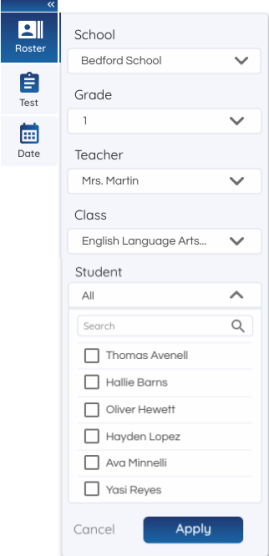
Administrators can select multiple teachers, classes, and schools to include in their report data. However, administrators cannot select more than one grade when choosing their report data. Administrators also have to select an appropriate report level if they want to access class, teacher, or student data when creating their reports.
It’s also worth noting that if a user selects teachers that share a class (primary teacher/teacher, teacher/teacher), the test data for that class is only represented once in the data set shown in reports and that if a class is selected that has more than one teacher, both names will be multi-selected in the teacher dropdown for that class.
See Select Data to Include in Reports for more information on using the Universal Selector and Roster Tab.
Using the Class List
The Class List allows administrators to see a list of how each class in their school is performing on the strand or standard they selected from the Standards Overview Table. Administrators can also use the bar above the list to filter by achievement level and use the arrows next to the column names to further sort the list.
For school administrators the default state is the administrator’s school and highest grade that has assessment data. If a school administrator has more than one school: The default state is the first school (in alphabetical order) and the highest grade that has assessment data. District administrators access an alphabetical list of all the schools in their district with relevant data when they first log in.
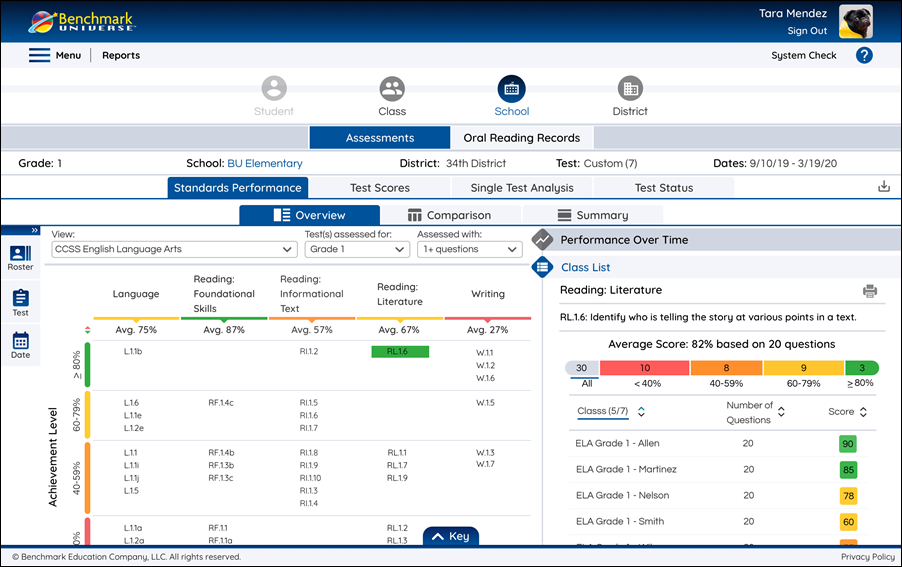
The Class and Schools Lists function similarly to the Student List for teachers. To learn more about navigating the Student List please see View Reports for Standards Performance.
Using the Comparison Tab as an Administrator
School and District administrators can access additional levels of analysis through the Comparison tab.
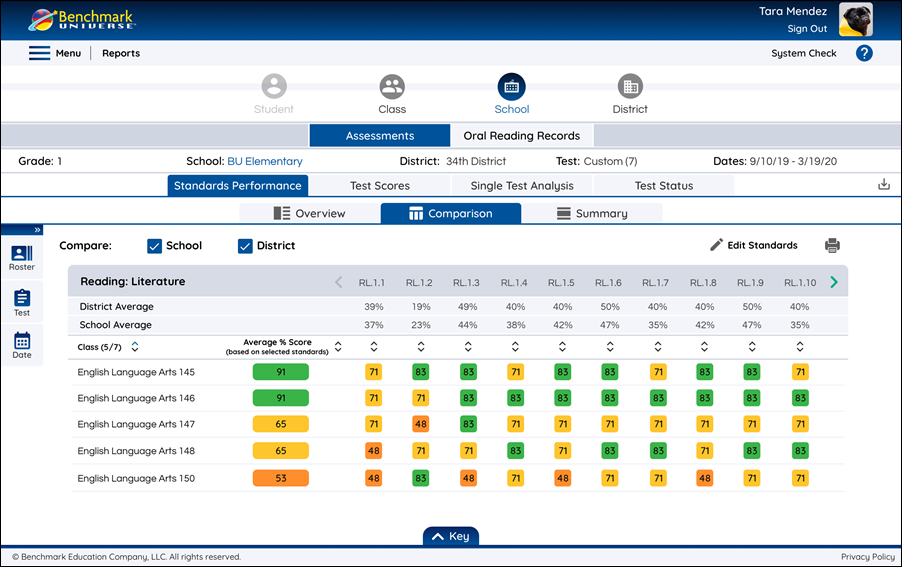
The Comparison tab provides administrators a chance to compare the performance of a single classroom (or multiple classrooms) to the standards or test performance of their entire school or district.
The Comparison tab functions in the similar way for administrators as it does for teachers. To learn more about navigating the Comparison tab, please see Create Standards Comparison Reports.
Using the Average Tab as an Administrator
School and District administrators can access additional levels of analysis through the Average tab.
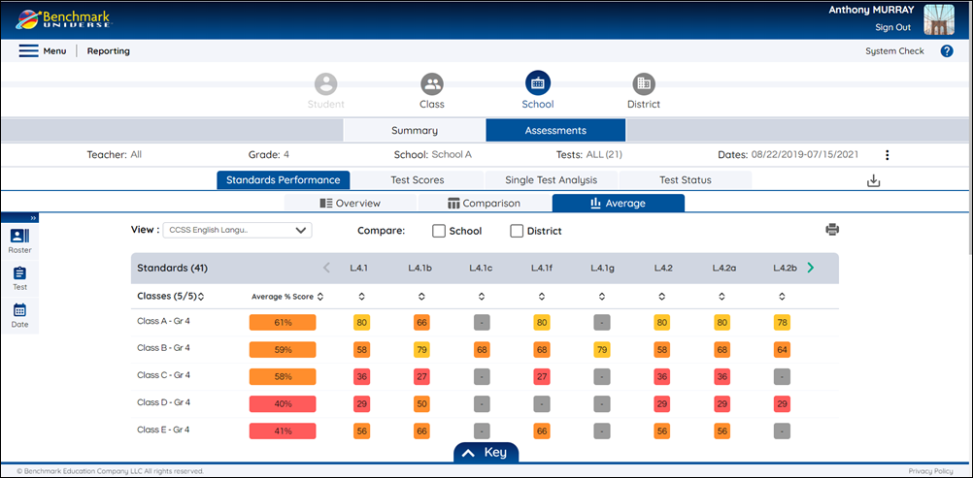
The Average tab provides administrators with a comprehensive view to see all standards assessed on a single test or multiple tests at the student, class, school, and district levels.
The Average tab functions in the similar way for administrators as it does for teachers. To learn more about navigating the Standards Average tab, please see Create Standards Average Reports.
Batch Printing as an Administrator
School and District administrators can print batch reports for Single Test Analysis and Average reports at a class level.
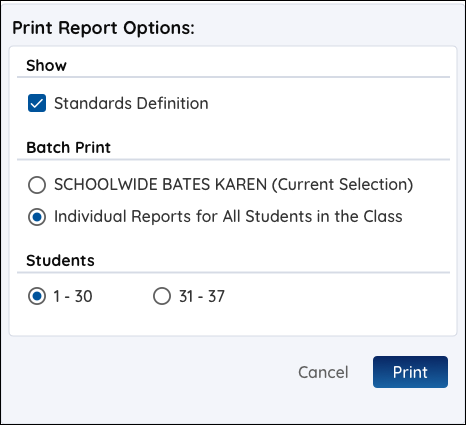
To learn more about batch printing, please see Batch Print Reports.
Create Test Status Reports as an Administrator
Administrators can create test status reports to see the current test statuses for a student, class, school, and district.

From the Detail section of the report at the Class level, administrators can drill down to Grade View for assignments in the “Needs to Be Graded” test status, and drill down to the Single Test Analysis report for those assignments that are in the “Complete” test status. They can also access those pages by using the status icons at the Student level.
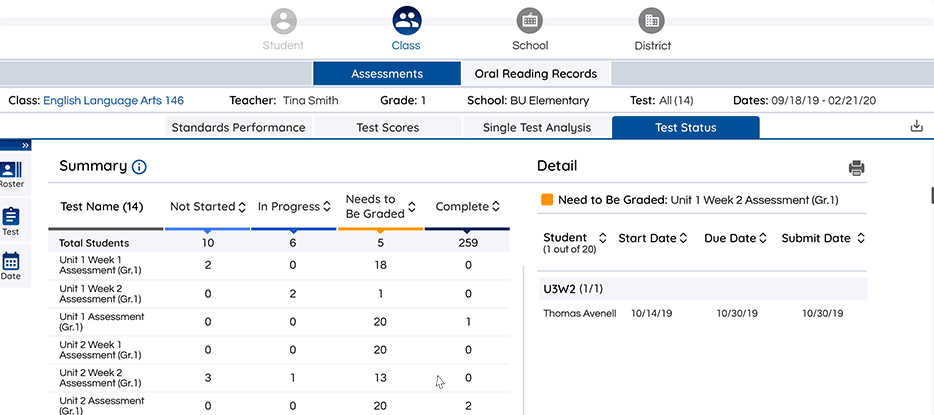
See Create Test Status Reports for more information.
Using Past School Year Reports as an Administrator
With Benchmark’s Past School Year Reports, administrators can see how their current roster of students performed in previous school years in comparison to their current cohort. Using Past School Year Reports allow administrators to analyze school and district level data to track performance, identify trends, and provide support to teachers and students so they can be successful.

|
Administrators can only access past term information for students in their current rosters. |
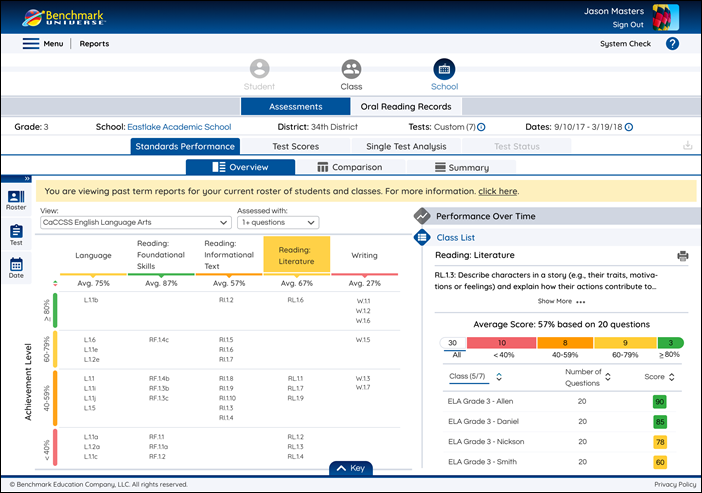
See View Past School Year Reports for more information.
